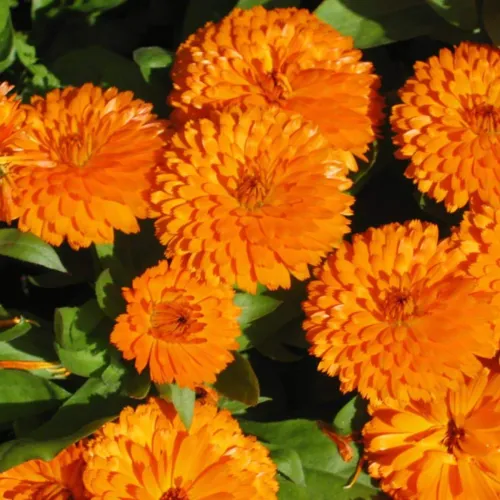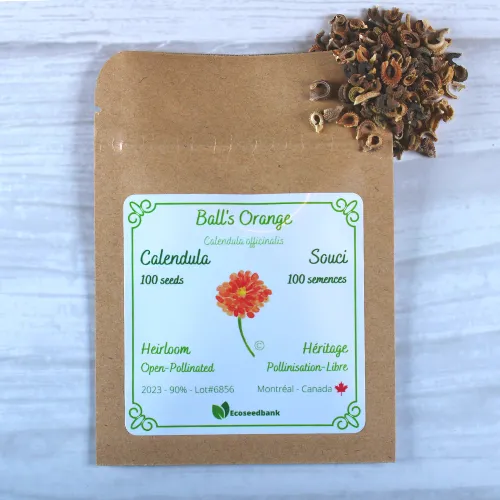Grown both as an annual flower and a medicinal herb, calendula has been used for thousands of years as a dye for fabrics, foods and cosmetics. Ball’s Orange is an old-fashioned variety that has been selected over for its production of large, fully double, orange flowers.
Growing up to 24 inches tall with blooms reaching 3 inches across, Ball’s Orange flowers are so big and numerous they sometimes show off more flowers than greens. Ball’s Orange calendulas are suitable for beds and borders and are a good addition in the pollinator garden.
- Latin Name: Calendula officinalis
- Life Cycle: Annual
- Days to Maturity: 80
- Planting Depth: 3-4 mm
- Plant Spacing: 15-45 cm
- Growth Habit: 30-50 cm tall
GROWING INSTRUCTIONS
Calendula, also known as pot marigold, is a sun-loving, daisy-like annual. Besides looking pretty, growing this flower has numerous benefits for the ecosystem and home gardener. It is an excellent companion for many garden crops, attracting native pollinators and repelling some pests. The blossoms are edible, medicinal and make a fantastic addition to any bouquet.
To get a jump on the season, seeds can be started indoors six weeks prior to the last frost date. Seeds started inside should be kept in darkness, in soil at 21 degrees until they germinate, usually in 1-2 weeks. Keep the medium moist throughout the germination process. Plant seeds at a depth of 5mm. Use 2-3 seeds per starting pot or plant more densely in flats and thin out as they grow.
Give seedlings bright light to prevent them from stretching and becoming leggy. Calendula will do just as well sown directly into the garden in the spring. Sow every couple of weeks until early summer to ensure constant blooming throughout the season. Keep in mind that individual plants should ultimately be spaced 15-45 cm apart. Mature plants will grow to be 30-50 cm tall, as well as 30-50 cm wide.
Provide your calendula with the sunniest possible site. This will encourage early vegetative growth and promote prominent blossoming. The soil should also be rich, preferably with a good amount of organic material and well-draining. Calendula has a low maintenance nature, and after getting established, shouldn’t require any supplemental fertilizing throughout the season.
Flowering should commence 6-8 weeks from seeding. The cheerful, yellow and orange blossoms complement vegetable gardens well. Tomatoes, asparagus, cucumbers, peas and carrots will all benefit from calendula growing nearby.
Although they love the sun, blossoms will thrive in cooler temperatures and low humidity. Pinching and cutting back early in the season and deadheading spent blooms will lead to bushier plants and more flowers during the growing season.
Calendula is quite cold tolerant and will endure some light frosts in the fall. Only a hard frost will kill them off definitively. Leave some mature flower heads and let them self-sow a patch that will sprout anew next spring.
Harvest blossoms late in the morning after dew has dried. Pick the flowers when fully open and add to a bouquet, sprinkle petals on a salad or dry flowers to use as seasoning later. With all its benefits, calendula is a welcome addition to any garden.
QUICK FACTS
- Calendula has been used in traditional herbal medicine to treat wounds, eczema, burns, and insect bites. The flowers can also be used as a natural food or fabric dye.
- The ancient Romans named this plant after its clock-like appearance, calendula meaning ‘’little calendar’’ in Latin.
- The ancient Greeks and Romans sometimes wore crowns and garlands made from calendula flowers.
- Calendula flowers are sacred in India, where they have been used to decorate Hindu statues for thousands of years.
- Also sometimes referred to as the ‘’poor man’s saffron,’’ calendula add in colour, rather than flavour, to rice and baked dishes.
- During the US civil war, most doctors carried dried calendula petals to stop bleeding and to promote the healing of wounds.
- Calendula seeds will remain viable for 3 years if stored in a cool, dark place, ideally between 4 and 10⁰C. After that, the germination rate may start to go down.













